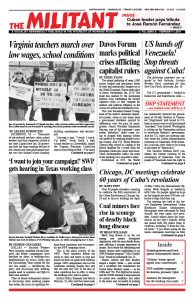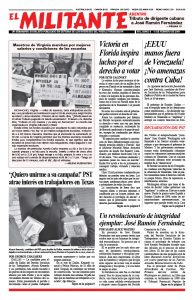Black lung disease is on the rise among coal miners throughout Appalachia, with the most deadly forms now affecting a younger generation of miners. Facts about this debilitating and deadly disease were highlighted in an NPR/Frontline program “Coal’s Deadly Dust” broadcast nationwide Jan. 22.
Miners, retirees and their families waged a mighty battle — and carried out a revolution that transformed the United Mine Workers union — in the 1960s and ’70s. This fight led to miners and the UMW winning a large measure of control over conditions and safety in the mines and succeeded in pushing back the scourge of black lung.
But since then bosses have been able to greatly increase the number of nonunion mines. In Kentucky there is no longer a single UMW-organized mine.
One in five working underground coal miners in Kentucky, Virginia and West Virginia today with at least 25 years on the job has black lung, the highest rate in a quarter of a century.
“But today miners in their 40s with 10 years of experience are getting diagnosed with progressive massive fibrosis,” James Werth, black lung program director at Stone Mountain Health Services in St. Charles, Virginia, said in a phone interview Jan. 25. “We’ve been seeing this for years and it seems to be increasing. Given that it’s a progressive illness we don’t see it slowing down anytime soon.”
Progressive massive fibrosis is an aggressive and often fatal form of black lung affecting miners as young as in their 30s or even 20s.
With big coal seams in Appalachia played out, miners have to cut through more rock to get to thinner seams of coal, producing toxic silica dust. These particles are so fine that respirators don’t capture them and they get imbedded in miners’ lungs. In their drive for profits the coal bosses are driving fewer workers to work longer hours, meaning miners face greater exposure to the dust.
While the National Institute for Occupational Safety and Health counted just 115 cases of advanced black lung nationwide from 2010 to 2018, NPR reported they “identified more than 2,300 cases by contacting health clinics across Appalachia.”
After nearly 2 1/2 decades in the mines, 44-year-old Danny Fouts told the Los Angeles Times he is no longer able to work. His lungs are now operating at less than 45 percent of capacity.
“There are people still working in mines that can have advanced stages of the disease and don’t know about it,” Werth said.
Coal bosses want to institute mandatory testing of miners, but workers have expressed opposition, knowing the companies will use these tests to get rid of workers whose health is starting to deteriorate, leaving them to fend for themselves to try to get measly government black lung benefits.
The way to eliminate the blight of black lung is to emulate what coal miners did several decades ago. Some 40,000 miners in West Virginia walked out of the mines in 1969, in a wildcat strike backed by the newly formed Black Lung Association. They forced the state legislature to pass a bill ordering coal bosses to pay compensation for black lung. Clinics were set up all over Appalachia.
The strike inspired thousands of miners to back Jock Yablonski in his run for president of the union that year in an effort to oust the corrupt Tony Boyle machine. Boyle hired thugs who shot and killed Yablonski, his wife and daughter.
Miners fought back. Joined by the Disabled Miners and Widows of Southern West Virginia, they succeeded in taking back their union. Miners set up union safety committees with the power to shut production — power they used — to enforce safety. Incidents of black lung declined more than 90 percent from the 1970s to the mid-1990s.

